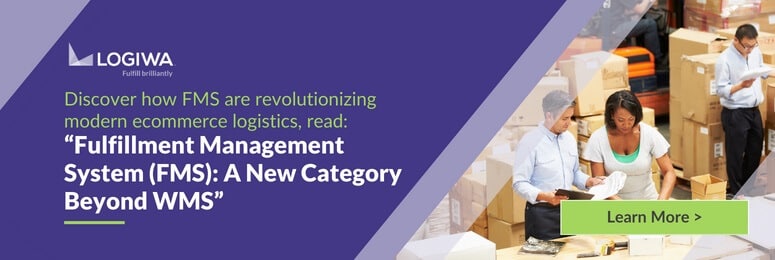The good news is that you can avoid such costly issues with warehouse inventory management software. In this guide, we discuss the benefits of inventory management software and how it can optimize your warehouse. Plus, we discuss 10 top inventory management platforms, so you can choose the right one for your warehouse.
First, here are the key takeaways you should know about warehouse inventory management systems:
- Warehouses without inventory management systems may experience stock loss, storage space waste, overstocking, and understocking. These issues lead to increased costs, a subpar customer experience, and other consequences.
- Warehouse inventory management software tracks and monitors goods stored within your facility.
- Real-time insights from inventory management systems facilitate inventory planning and decision-making to prevent stockouts, understocking, or overstocking.
- Pick the best inventory management software by checking the price, feature set, and user-friendliness of each platform you consider.
- Logiwa WMS is often the best value over the competition because it’s more user-friendly, configurable, and feature-rich.
Contents
What Is Warehouse Inventory Management Software?
Warehouse inventory management software digitally tracks inventory (stock) within your storage facility. Think of it as a smart organizer that keeps you constantly updated about what’s in your warehouse, where you stored each item, and when items go in or out.
The system typically relies on barcodes or RFID tags to label and identify inventory items for storage and maintain its digital records. Knowing your stock status and levels simplifies making well-informed inventory control decisions regarding restocking, completing orders, and storage optimization.
Why Your Warehouse Needs Inventory Management Software
Warehouse inventory management software brings order to the chaos most facilities experience with receiving, storing, picking, packing, and shipping items. Below are specific ways inventory management improves these warehouse processes.
- Error reduction: The software automates tracking inventory to prevent issues such as misplacing items within your warehouse. It also eliminates the need to update inventory records manually, leading to fewer errors that compromise inventory control.
- Real-time visibility: The system provides up-to-date insights regarding your inventory levels and location. The accurate information helps improve inventory planning and decision-making to prevent stockouts, understocking, or overstocking.
- Cost savings: The software constantly keeps track of all your inventory to reduce the likelihood of theft or loss. Reducing inventory theft and loss is crucial because such incidents cost warehouses millions of dollars each year.
- Reporting and analytics: The software provides reports that offer insights into inventory trends and turnover rates. The information is useful for planning and optimizing restocking to keep pace with customer needs.

How to Evaluate Warehouse Inventory Management Software
Several warehouse inventory management platforms are available, and every product is different. Pick the right software for your warehouse by looking at the following: price, features, and user-friendliness.
Price
A warehouse inventory management software should offer the features you want without exceeding your budget. So, choose a product with a pricing plan that fits your budget and features to help you achieve your inventory management goals.
Features
The best warehouse inventory management solutions offer a host of features to help optimize stock management. Features will vary between products, but the software should at least be scalable and capable of seamless integration with your existing warehouse systems.
The software should also offer mobile accessibility, barcode/RFID support, real-time visibility, and reporting and analytics.
User-Friendliness
Choose a warehouse inventory management system that’s easy to implement and use. A user-friendly inventory manager is crucial because it shortens your time to value, allowing you to experience faster returns on investment.
Warehouse Inventory Management Comparison Table
| Key Features | Integrations | Hosting | Use Case | |
| Logiwa | ||||
|
|
|
|
|
| Cin7 | ||||
|
|
|
|
|
| Zoho Inventory | ||||
|
|
|
|
|
| inFlow | ||||
|
|
|
|
|
| NetSuite Inventory Management | ||||
|
|
|
|
|
| Lightspeed | ||||
|
|
|
|
|
| ShipBob | ||||
|
|
|
|
|
| Flowtrac | ||||
|
|
|
|
|
| Katana | ||||
|
|
|
|
|
| Ordoro | ||||
|
|
|
|
|
1. Logiwa
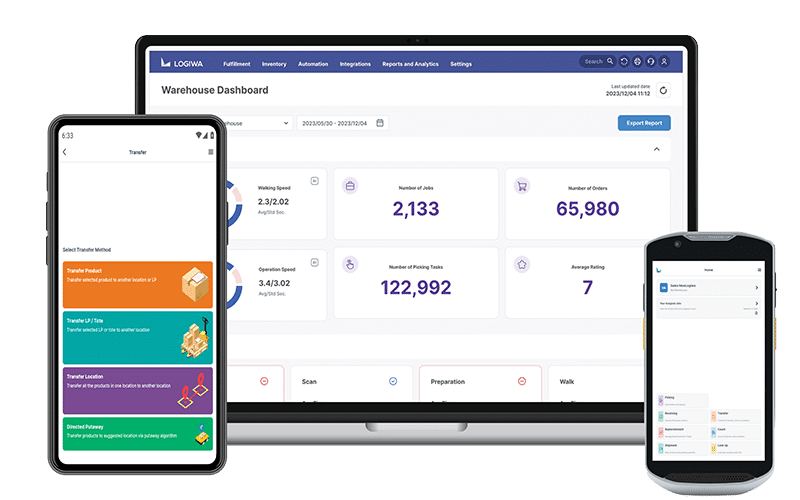
Rating: 4.2/5 (G2)
Key Features:
- Real-time inventory visibility and control
- Storage optimization
- Pre-integrated with ecommerce, shipping, accounting, and robotics solutions
- Smart automation
- Scalable and adaptable
- Mobile app
- Stock reporting and demand forecasting
- Easy and quick onboarding
Logiwa WMS is a comprehensive warehouse management system that can double as your warehouse inventory management software. The cloud-native system provides complete, real-time visibility and control over your inventory to help you avoid costly stockouts and shortages.
It also equips you to manage and automate multiple warehouse processes effectively. For example, you can automate inventory receiving, putaway, and picking processes to automate replenishment and order processing. Logiwa clients often save hours per day and hundreds of dollars per month by automating inventory tracking processes.
The inventory management software’s configurability allows you to adapt it to your unique needs. Also, since the tool is highly user-friendly (no coding required), you can onboard and get your return on investment quickly. The ease of onboarding and configuration makes Logiwa competitively priced because you pay lower professional service fees to deploy the software.
Another reason to choose Logiwa for inventory management is its hassle-free integrations. For example, you can integrate it with your existing shipping, ecommerce, and warehouse systems to monitor every inventory movement, including goods in transit and returned goods.
The software’s versatility makes it suitable for various B2C, B2B, DTC, and 3PL facilities, and the Logiwa mobile app facilitates remote inventory management and monitoring.
2. Cin7
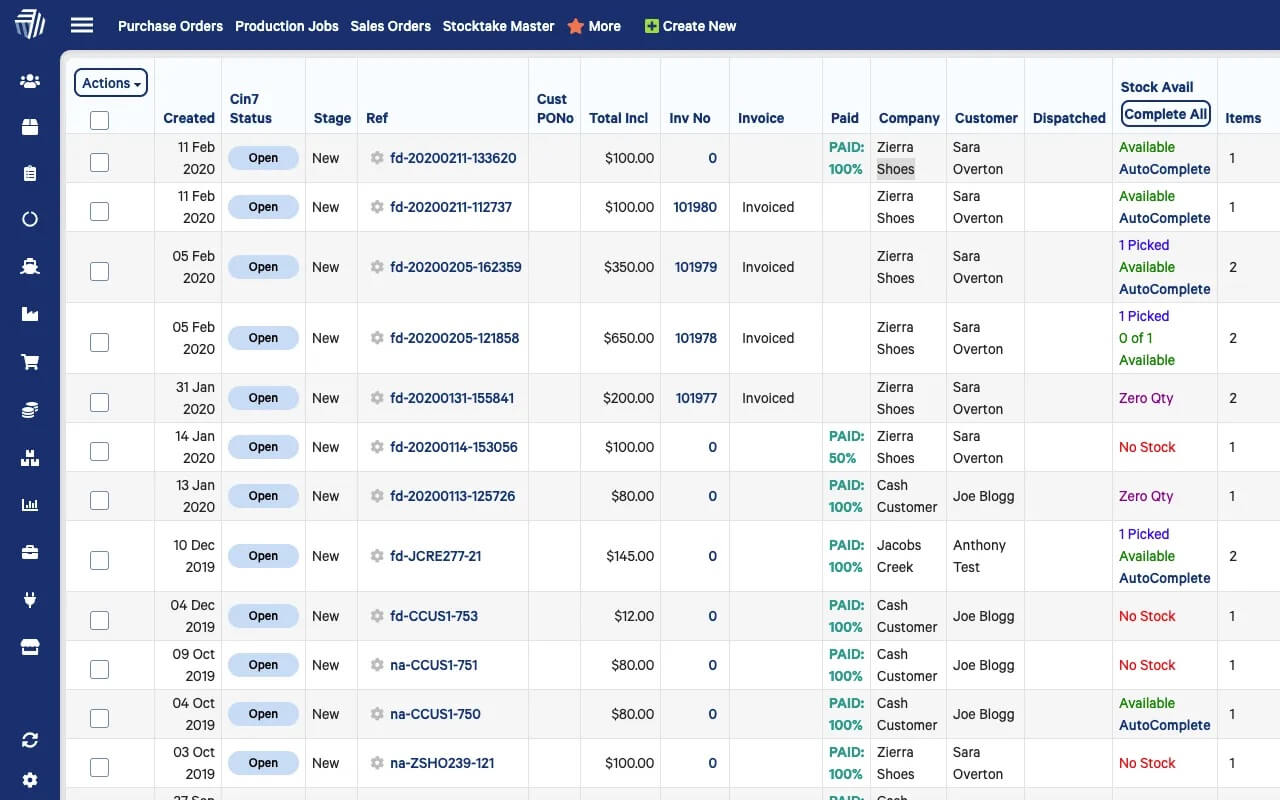
Rating: 3.6/5 (G2)
Key Features:
- Ecommerce and Point-of-Sale integrations
- Reports and analytics
- Automation
- Real-time inventory insights
Cin7 is a cloud-based inventory manager that provides a clear picture of your end-to-end inventory operations. With the software, you can handle purchase orders, inventory storage, order fulfillment, returns, and more in one place. However, the specific features you can access will depend on whether you choose Cin7 Core or Omni.
Core offers the basic features you need to manage your inventory and comes with many integrations for seamlessly connecting with commonly used warehouse systems.
Omni, on the other hand, lets you custom configure the Cin7 inventory manager to match your needs. It also offers more integration options and EDI and 3PL capabilities. Pricing starts at $325 per month for Cin7 Core, while Cin7 Omni will require getting a custom quote.
3. Zoho Inventory
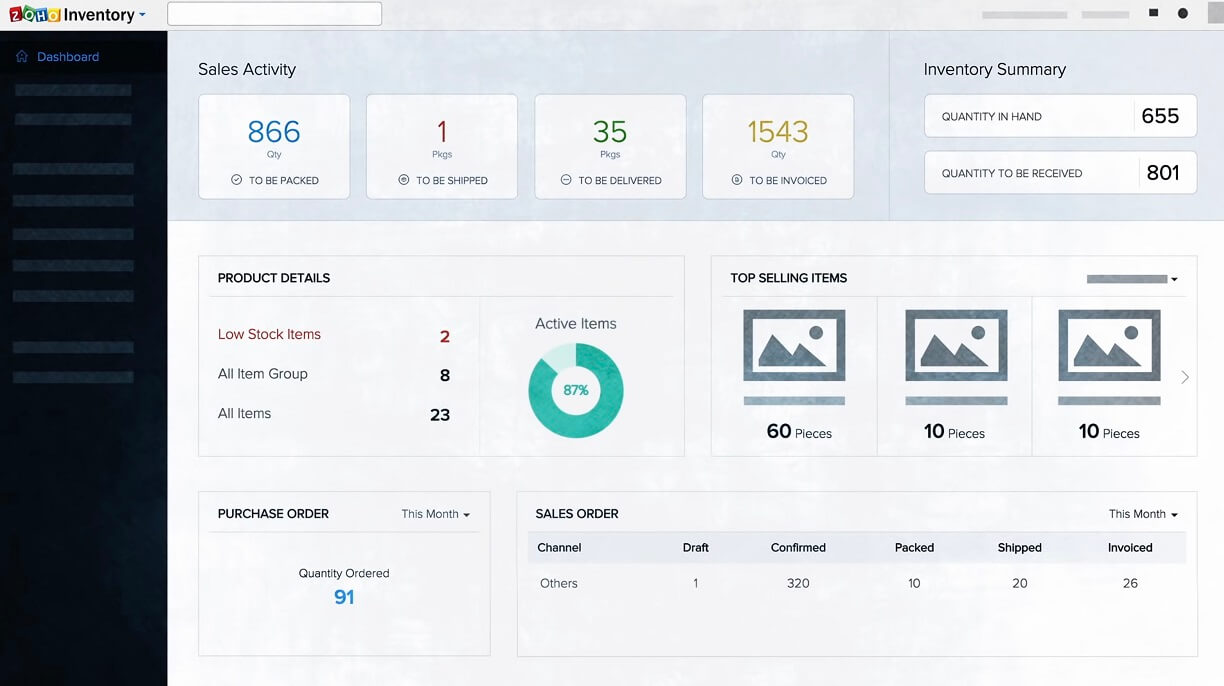
Rating: 4.3/5 (G2)
Key Features:
- Hundreds of integrations
- Reporting and analytics
- Barcode and RFID systems
- Stock management across multiple warehouses
Zoho Inventory helps warehouses manage stock from receiving and storage to sales and shipping. Its batch tracking feature helps you automate labeling and storing inventory with a barcode and inventory system. You can then receive real-time alerts each time any registered inventory changes location within or outside your warehouse.
If you run a B2C business, you can connect Zoho Inventory to multiple sales channels and sync stock effortlessly. The synchronization will keep you updated regarding items sold via each channel.
Zoho Inventory offers many integration options for automating warehouses and seamlessly collecting and transferring data. For example, you can integrate with shipping partners to monitor goods in transit or your accounting system to trigger custom actions when an invoice becomes overdue.
While Zoho offers a limited free plan, you’ll need a paid plan to process more than 50 orders monthly. Pricing starts at $59 per organization/month.
4. inFlow
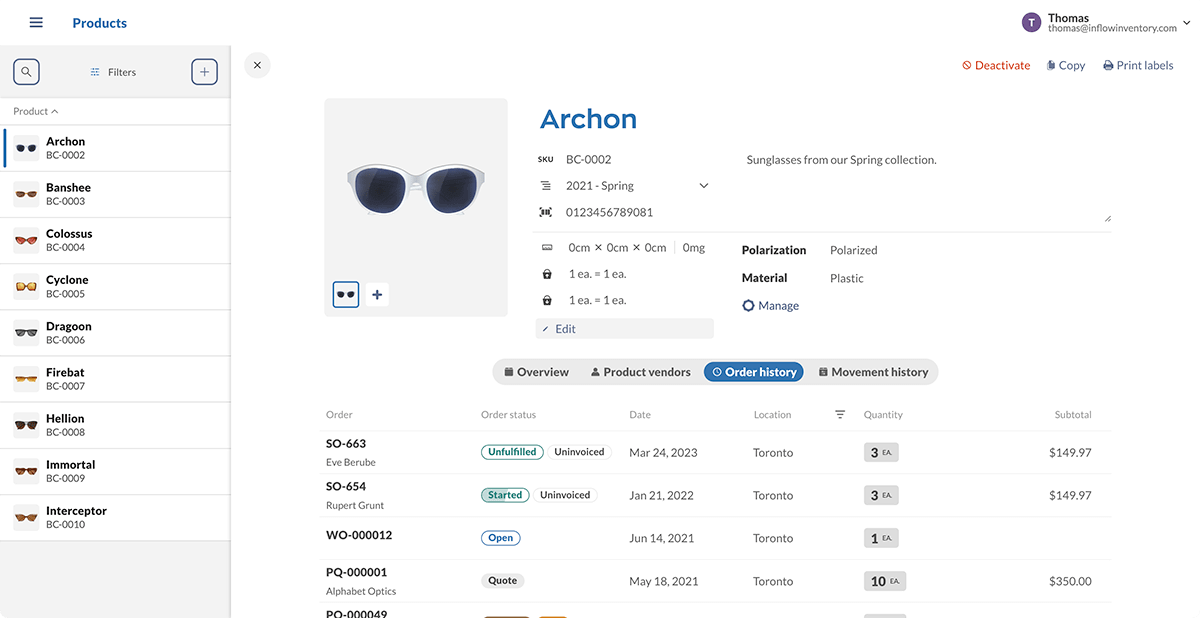
Rating: 4.1/5 (G2)
Key Features:
- Many integrations
- Barcoding
- Inventory control
- iOS and Android mobile apps
inFlow eliminates the need to monitor inventory with manual, tedious methods. Instead, you can use the smart software to get automatic updates regarding what’s in stock and new orders, preventing issues such as overstocking or stockouts. Plus, you can do it all from your phone with the inFlow Android or iOS app.
Another impressive feature is inFlow’s barcoding for generating unique SKUs for products and creating labels for incoming or outgoing items. Each label will have a barcode that you can scan to identify and track inventory items.
Pricing starts at $89 per month when billed annually. The basic plan only supports one integration and a hundred sales orders per month. If you want more, you’ll need a more expensive plan.
5. NetSuite Inventory Management
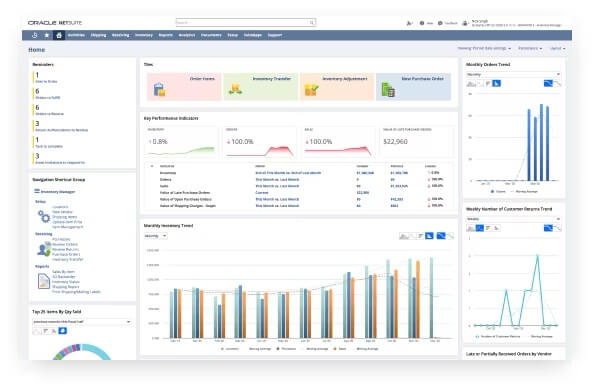
Rating: 4.0/5 (G2)
Key Features:
- Automated inventory level tracking
- Multi-location fulfillment
- Demand-based replenishment
- Item 360 dashboard
NetSuite Inventory Management’s Item 360 Dashboard allows you to view what’s happening to inventory in multiple facilities in real time on one device. This unified view gives you easy access to relevant data regarding your warehouse and inventory, such as inventory count by location.
The system also provides insights regarding inventory levels and stocking, so you can make data-driven restocking decisions. For example, leveraging historical and seasonal sales data lets NetSuite help you set up automated demand-based inventory replenishment.
Pricing is customized based on your needs. For more information, you must contact sales.
6. Lightspeed
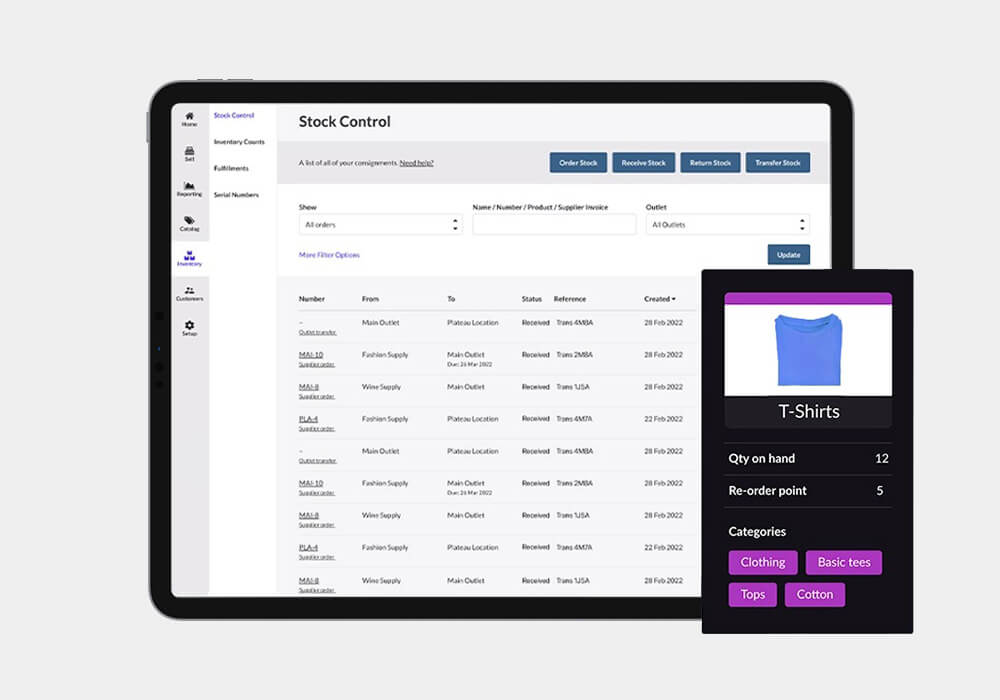
Rating: 4.0/5 (G2)
Key Features:
- Inventory management
- Advanced reporting
- Barcode generator
- Integrations and API
Lightspeed is an inventory management system built for B2C businesses, such as retailers and hospitality service providers. With the software, your SMB can manage inventory, contact suppliers, and monitor outgoing goods at multiple sale points.
The platform’s scalability ensures it can adapt to meet your needs as your company grows. It also offers analytics and reporting for tracking inventory shrinkage and other discrepancies that cause good and revenue loss.
If you run into trouble with the software, you can quickly get help from Lightspeed’s fast 24/7 support team. Lastly, Lightspeed offers a barcode generator for automatically creating barcodes to label and track goods.
Pricing starts at $69 per month. Additional plans exist, including Standard, Advanced, and Enterprise.
7. ShipBob
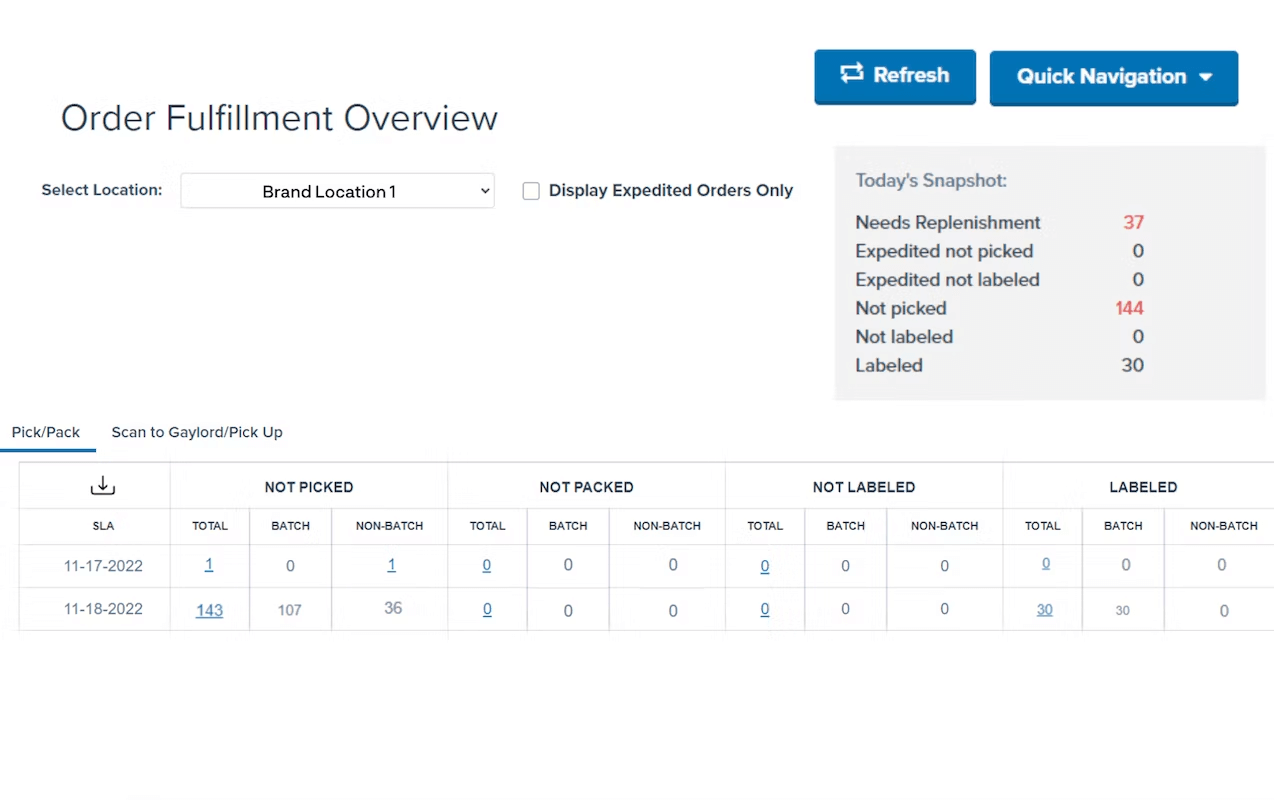
Rating: 3.6/5 (G2)
Key Features:
- Inventory distribution and tracking
- Customizable interface
- Apps and APIs
ShipBob is a warehouse management system with advanced ecommerce inventory management tools. With the inventory management system, you can seamlessly manage inventory control in multiple stores and fulfillment centers.
Since ShipBob integrates with all the major ecommerce platforms, you’ll have no trouble integrating it with your store to monitor sales, shipping, and other order fulfillment processes. Monitoring order fulfillment processes will provide insights into demand and stock levels. This information is crucial for forecasting and automating inventory restocking.
ShipBob doesn’t disclose its pricing publicly. You must contact sales for more detailed information.
8. Flowtrac
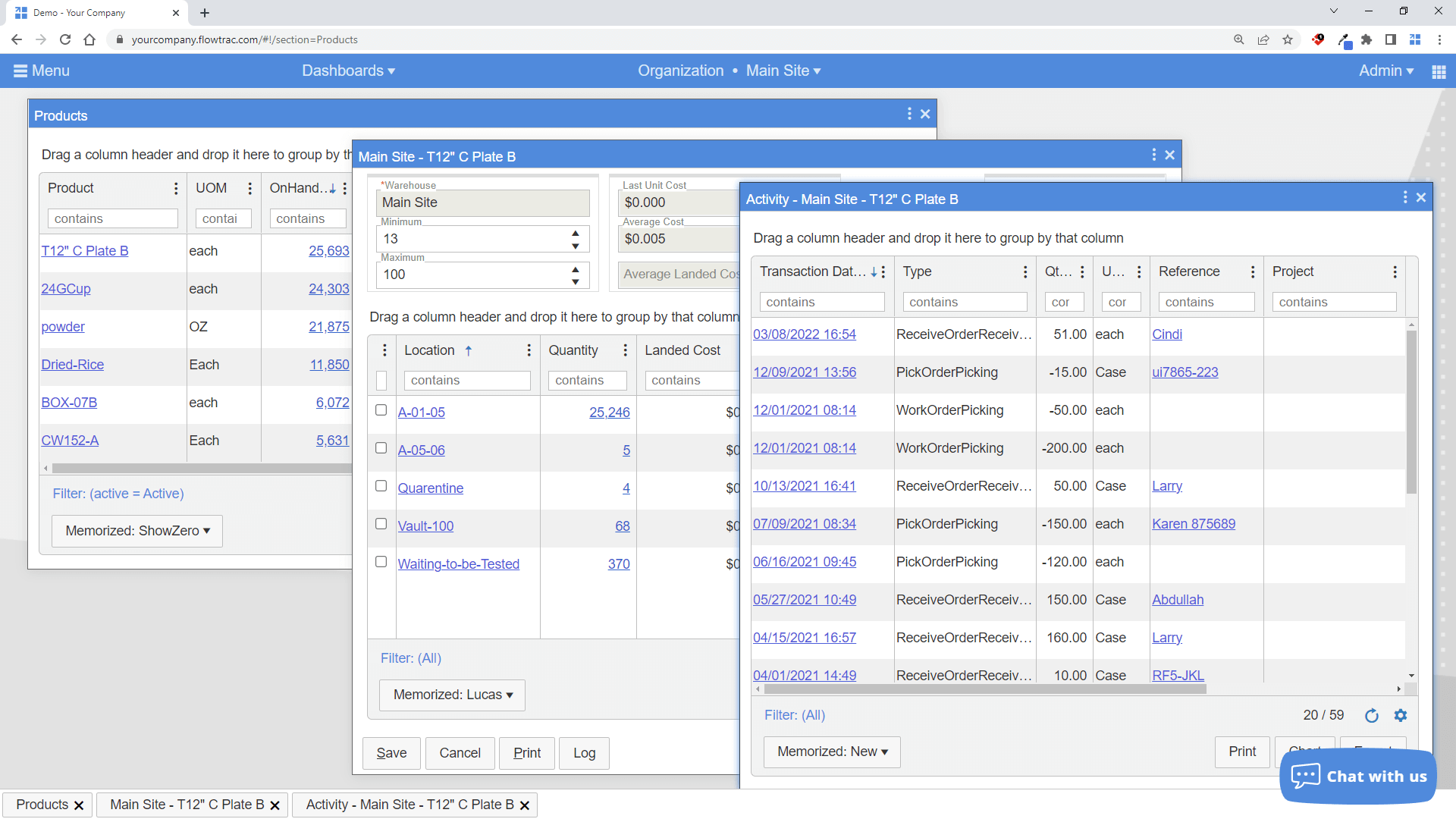
Rating: 4.4/5 (G2)
Key Features:
- Ecommerce and accounting software integration
- Barcode scan and RFID read features
- Inventory tracking
Flowtrac helps organizations manage inventory, delivery, and other warehouse functions. Depending on your needs, you can use Flowtrac as a cloud-based or on-premise solution. The on-premise route is ideal for organizations that want more control over data and security, such as government bodies and large corporations.
Regardless of the option you choose, the software will directly integrate with your online store to monitor order fulfillment and automatically update inventory records. For pricing, you must contact sales.
9. Katana
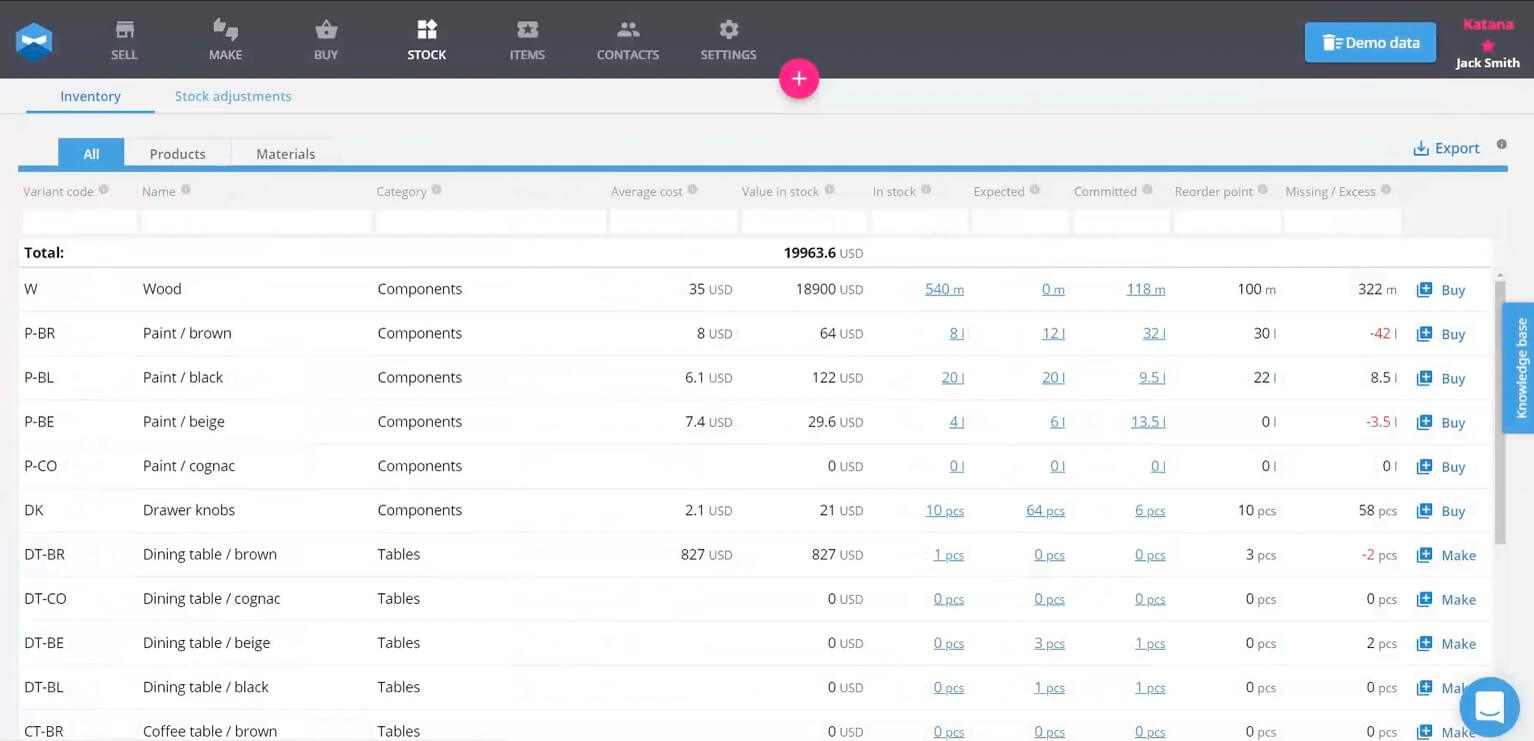
Rating: 4.4/5 (G2)
Key Features:
- Live inventory management
- Omnichannel order management
- End-to-end traceability
- Open API integration
Katana offers manufacturing warehouses a user-friendly solution for monitoring and managing inventory in real time. The platform’s live inventory management tool allows you to optimize and control storage and product stock. The feature ensures you always have end-to-end visibility of finished products, raw materials, and other inventory within and outside your warehouse.
Katana’s open API and no-code solution simplify integrating the system with hundreds of ecommerce, shipping, accounting, and reporting platforms. Integrated systems can exchange data to update databases and give you real-time notifications automatically.
Katana’s Essential pricing plan starts at $99 per month when billed annually. There are other pricing plans to choose from, depending on your needs.
10. Ordoro

Rating: 4.7/5 (G2)
Key Features:
- Automatic low-stock alerts and reporting
- Supplier management
- Multi-warehouse management
- Purchase orders and goods receipts
Ordoro is for ecommerce businesses that want better control over inventory. The system offers automated low-stock alerts and reporting so you can replenish on time to avoid stockouts. You can also monitor and manage supplier and purchase transactions, so you know when to expect fresh inventory.
Since Ordoro provides full visibility and control over your inventory, you can make more informed decisions to optimize storage and warehouse processes. Ordoro can serve as your one-in-all tool for monitoring multiple sales channels and warehouses.
A free plan is available, but you need a paid plan to access the sales channel management and automation capabilities. Pricing plans start at $59 per month.
Simplify Inventory Management With Logiwa
As you can see, you don’t have to make do with managing your warehouse inventory manually. Several warehouse inventory management software platforms are available for monitoring, managing, and automating inventory storage, movement, and processing.
However, compared to other options, Logiwa WMS is more user-friendly, robust, and versatile. Logiwa WMS comes with various features for managing and optimizing inventory and several other warehouse processes. Plus, you can quickly integrate Logiwa with your existing system and configure it to match your needs, reducing time to value.
Request a demo of Logiwa WMS today and experience the many ways you can use it to your advantage.
Inventory Management Software FAQs
Q: What is the importance of warehouse inventory management for B2C, DTC, and 3PL providers?
A: Managing warehouse inventory is a critical task for B2C, DTC, and 3PL providers. Without effective inventory tracking and management, there’s a risk of inventory loss, wasted warehouse space, overstocking, and understocking, leading to increased costs and a subpar customer experience.
Q: How can warehouse inventory management software benefit warehouse operations?
A: Warehouse inventory management software helps in tracking and monitoring goods stored within the facility. It provides real-time insights that facilitate inventory planning and decision-making, preventing stockouts, understocking, or overstocking. This software can optimize warehouse operations by reducing errors, offering real-time visibility, saving costs, and providing valuable reporting and analytics.
Q: What are the consequences of not having an inventory management system in a warehouse?
A: Warehouses without inventory management systems may experience stock loss, storage space waste, overstocking, and understocking. These issues can lead to increased costs, a subpar customer experience, and other negative consequences.
Q: How does warehouse inventory management software function?
A: Warehouse inventory management software digitally tracks inventory within a storage facility. It typically relies on barcodes or RFID tags to label and identify inventory items for storage and maintain its digital records. This system provides constant updates about the stock status, simplifying inventory control decisions regarding restocking, order completion, and storage optimization.
Q: What are the key features to consider when evaluating warehouse inventory management software?
A: When evaluating warehouse inventory management software, one should consider the price, feature set, and user-friendliness. Essential features include scalability, seamless integration capabilities, mobile accessibility, barcode/RFID support, real-time visibility, and reporting and analytics.
Q: How does warehouse inventory management software enhance error reduction in warehouses?
A: The software automates inventory tracking, preventing issues like misplacing items within the warehouse. It also eliminates the need for manual updates to inventory records, leading to fewer errors that compromise inventory control.
Q: What cost implications are associated with not having an effective inventory management system?
A: Without an effective inventory management system, warehouses face the risk of theft or loss of inventory. Such incidents can cost warehouses millions of dollars each year.
Q: How does Logiwa WMS stand out among other warehouse inventory management software?
A: Logiwa WMS is a comprehensive warehouse management system that provides complete, real-time visibility and control over inventory. It is user-friendly, versatile, and feature-rich, offering automation for various warehouse processes. It also boasts easy integration with existing systems and is suitable for various B2C, B2B, DTC, and 3PL facilities.
Turn High Volume DTC fulfillment excellence into your competitive advantage
Warehouse Management
Modern digital WMS powers a modern fulfillment experience


